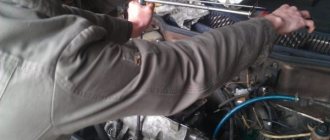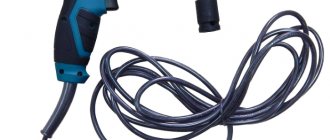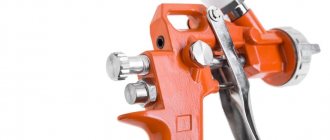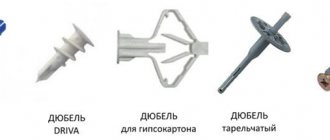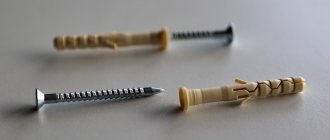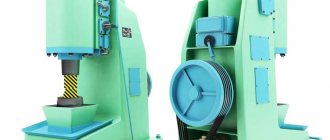For a modern mechanic, a compact pneumatic impact wrench is an indispensable and convenient tool when quick disassembly or fixation of threaded connections is required. There are many models of this device for repairing personal household mechanisms, use in construction, and mechanical engineering.
Operating principle of a pneumatic impact wrench
Like any pneumatic tool, a pneumatic impact wrench is powered by compressed air supplied from a compressor.
Bypassing the hose connected to the impact wrench, the air enters the device and begins to spin the rotor blades, which transmits rotation to the spindle (stop), the nozzle and, ultimately, to the fasteners. The reverse function changes the direction of air flow in the tool, as a result of which the direction of rotation of the rotor changes, and the nut is unscrewed in a few seconds. Depending on the type of work, pneumatic impact wrenches can be impact or non-impact. The presence of an impact mechanism in the impact wrench increases its torque, but at the same time the risk of stripping the thread or bolt head also increases. The impact-rotational movement is created using a special hammer mechanism located in front of the spindle. Devices without an impact function often produce less rotational force and are mainly used when working with fasteners up to 12 mm.
Delving into the details, we can outline the device of a pneumatic impact wrench as follows. Inside the tool body there is a back panel, a cylinder with a rotor and blades, an impact mechanism, and a stop. On the outer part of the case there is a start button, a fitting for connecting the compressor, a reverse and a regulator (on most models).
We recommend that current or future owners read the material where we tell and show how to maintain and repair a pneumatic impact wrench.
Pneumatic impact wrench with adjustable torque
Most modern impact wrenches are equipped with a torque control feature. The main task of this function is to prevent fasteners from overtightening, thread or head breakage. Adjustment will be useful for tightening relatively small nuts and bolts with a high torque tool. The fasteners on the M8 will most likely be damaged if you tighten them with a tool without a regulator, with a maximum torque of 1000 Nm.
The principle of operation of an adjustable pneumatic impact wrench is to limit the supplied air, as a result of which the torque is reduced. For example: if you set mode number 3 on a Fubag pneumatic impact wrench at 900 Nm, its torque will drop to 450 Nm, which will allow you to confidently tighten the M14 fasteners. The number of modes on different instruments may vary, but on average there are from 3 to 5. Information about operating modes is indicated in the documentation supplied with the tool. Each individual device has its own characteristics of adjustable power.
Rules for applying lubrication
If for some reason you are unable to install a lubricator on your unit, then you can get out of the situation in the following way.
- Immediately before starting the impact wrench, you need to unscrew the hose from it and drop 3 to 5 drops of lubricant into the tool fitting.
- Next, you should return the hose to its original place and turn on the unit for a short time (thirty seconds will be enough). Thanks to this operation, the oil will be evenly distributed over all moving parts of the device.
Lubrication in this way must also be carried out before long-term storage of the tool. When using the unit in intensive mode, oil should be dripped into the fitting every 3-4 hours.
Although this method helps to extend the life of the impact wrench, it is very inconvenient. You have to interrupt work and spend time cleaning the tool from contaminants in the area of the fitting and preparing lubricant. Also, during the procedure, you should carefully ensure that no dust gets into the unit. It is for these reasons that it is recommended to install a lubricator in the system, which will always supply lubricant to the tool in a timely manner.
How to Choose a Pneumatic Impact Wrench
Before you go to the store to buy an air impact wrench, you should ask yourself a few important questions, the answers to which will help you make a successful purchase. This tool has many features and applications, so the performance indicators of different models may vary significantly. One specific impact wrench may be successfully used in one type of work, but completely unsuitable for another. What you need to consider when choosing:
- Scope of application
. Determine for yourself what types of work the tool will be used for. Do you need a pneumatic wrench for the garage, a compact device for installing ventilation, or a large unit for loosening truck wheels? - Nut dimensions
. The more compact the fastener, the less tightening force it requires. If you have to twist nuts with thread sizes from M6 to M10, a 1/2 square fit is suitable. A 3/4 square impact wrench is suitable for fasteners with M10 – M18 threads. For larger nuts, a 1-inch square will be optimal. - Torque
. Based on the specific type of work, a tool with a suitable torque is selected, which is usually in the range from 300 Nm to 3000 Nm (not taking into account the industry giants). The wheels of a passenger car can break away at 300-400 Nm, Kamaz wheels at 800-1000 Nm, and extremely loaded joints can only be succumbed to a tool with a rating of several thousand. - Tightening regulator
. An important factor that adds versatility to the tool. The adjustment expands the range of fasteners that can be tightened, but on pneumatic impact wrenches it has an error of 10%. - Device weight
. Working for a long time with a heavy tool with vibration can make life quite difficult. If you choose a pneumatic impact wrench for the garage and small household work for a few minutes a day, then a unit with an all-metal body is suitable. For longer-term use, it is better to take a lighter tool, with a body made of composite materials.
Be careful, air impact wrench!
Have you ever read on auto forums the surprised reviews of car enthusiasts that ten kilometers after visiting a tire shop or service station, they discover that the bolts on one (or several) wheels are not just not tightened, but are simply unscrewed or even lost? ? And the strangest thing is that the wheels were tightened in the presence of the “warmer”! Therefore, such situations are usually attributed to evil neighbors. In fact, the cause of this phenomenon in most cases is a pneumatic impact wrench.
Pneumatic pistols
(pneumatic impact wrenches), due to their low cost, in recent years have firmly entered the list of tools available in almost any tire shop or service station. A pneumatic impact wrench really significantly speeds up the process of dismantling/installing a wheel and significantly facilitates the work of the master. True, only a few car enthusiasts know that screwing and tightening wheel bolts (nuts) with a pneumatic impact wrench is strictly prohibited!
How do air impact wrenches work?
The design of pneumatic impact wrenches, which are used in tire shops, is quite simple: the pneumatic gun is connected to the compressor hose and is driven by high-pressure air. An important element of the design of the pneumatic gun is the ability to adjust the maximum force transmitted to the pneumatic wrench cartridge, thanks to which, in particular, the tightening torque of the bolts (nuts) can be adjusted. This is precisely the main argument of tire mechanics in favor of using a pneumatic impact wrench when tightening bolts - the tightening torque is set to a minimum, which means the bolts (nuts) will not be “overtightened”.
In fact, pneumatic devices
cannot be used when attaching a wheel to a hub, not at all because of the tightening force, although, given the fact that in the vast majority of cases, air impact wrenches in tire centers are cheap Chinese products and adjusting the tightening torque is the first thing that breaks in them ( if it worked at all), there is absolutely no reason to trust these devices and the situation when problems arise the next time you dismantle the wheel is more than likely and vital. But the point is not even that the bolts may be too tightly (or too loosely) tightened when mounting the wheel.
Why do mounting bolts (nuts) have a tapered base?
Have you probably noticed that the bolt holes on the discs have a much larger diameter than the threads of the bolts (studs) that secure the disc to the hub? And, accordingly, do the bolts (nuts) themselves have a head with a conical base? Have you ever wondered why this was done? And this is done because the car manufacturer is forced to very accurately calculate the fit of the wheel disk on the hub so that the axis of rotation of the disk exactly coincides with the axis of rotation of the hub. If these axes do not coincide, the wheel will break, literally destroying the wheel bearing and other load-bearing elements of the suspension. Moreover, the task is not only to correctly “plant” the wheel on the hub, but also to securely secure it in this position in all load axes. That is why there is a centering hole for the disk (for correct fit) and rules for alternate and step-by-step tightening of the wheel bolts - for reliable fixation in the correct position. More information about the purpose of the centering hole and cones can be found in the article on centering rings.
By tightening the bolts (nuts) according to the rules, i.e. manually, using a professional tool, slowly, using the star principle and in several stages, you ensure the most accurate alignment of the disc bolt holes on the conical bases of the bolts (nuts), and, accordingly, the most reliable fastening of the disc to the car hub in the desired position. What happens when you tighten bolts with a pneumatic impact wrench? Under high pressure and at high speed, one bolt (nut) is screwed (and tightened), and, regardless of whether it “fits” correctly into the bolt hole of the disk and whether the other holes “fit” correctly in relation to the studs (tapped holes) hubs. And after that, all other bolts are forced to be tightened based on the position that the wheel occupied relative to the hub when the first bolt was tightened.
Just for fun, try putting the wheel on the hub and tightening only one bolt (nut), but without tightening it all the way - you will see that the wheel will have quite a serious “play”
What can be the consequences of pneumatic tightening of bolts (nuts)?
If the wheel seats on the hub incorrectly, this means that the holes on the disk and the conical bases of the bolts or nuts “sat” incorrectly. And this, in turn, means that two forces will collide while the car is moving: either the beating wheel will break the bearing (relevant for cases when the diameter of the centering hole of the disk does not exactly coincide with the diameter of the hub landing cylinder), or the wheel will still shift (for example, when emergency braking) and will snap into place (depending on the actual tightening torque of the bolts). In the first case, the consequences are clear, but in the second, when the bolts fall into place, it turns out that they are... not tightened! Well, then the vibration of the wheel and the centrifugal force will inevitably do their job - the bolts (nuts) will sooner or later come loose. It's good if you have time to notice it...
Compressor for pneumatic impact wrench
The most important piece of equipment needed to operate a pneumatic tool is an air compressor. This device, using a motor, pumps air into itself and directs it through a special hose into the tool. Let's look at how to choose a compressor for a wrench to suit all your needs.
- Pressure
. The force of compressed air output, and therefore the performance of the tool, depends on this characteristic. For most medium-sized impact wrenches, a low-pressure compressor delivering at least 6.3 atmospheres is sufficient. - Maximum performance
. An important indicator on which the speed of operation of the tool depends. If a pneumatic impact wrench indicates a flow rate of 360 liters per minute, but the compressor pumps only 330 during the same time, you can forget about uninterrupted operation in such a combination. The compressor's performance must be higher than the impact driver's needs. - Receiver volume
. A rather controversial indicator that determines the battery life of a tool in the absence of constant air pumping. Compressors with a small volume of air (50 liters) quickly lose pressure and for continuous operation of the tool, they must constantly pump air. With more impressive volumes (100-200 liters), the equipment can rest a little, despite the continued operation of the pneumatics. For convenient work in the home workshop, the compressor for the impact wrench will have 100 liters. - Connection type
. To deliver compressed air to the gearbox of a pneumatic impact wrench, a special sealed hose is required that can withstand the applied pressure. Before purchasing such a hose, you should find out what size fitting it fits (1/4, 1/2 or 3/4). The manufacturer indicates this data on the instrument itself, in the documentation or on the box.
article from the Rating section
- 40
Pneumatic tools Locksmith tools
Save this page on your social media. network and return to it at any time.
ADD A COMMENT
Hose selection
You should know that the hose that comes with the compressor, especially one made in China, is not suitable for the effective operation of the impact wrench. Most often, these hoses have an internal cross-section of about 6 mm. This hose capacity will not be enough to supply the required volume of air to the pneumatic tool. They can, perhaps, blow off dust, use them for a spray gun, but nothing more. Even inflating tires with it takes a lot of time.
Therefore, it is necessary to acquire another hose with greater throughput. Ideally, this could be a gas hose, which can be purchased at a gas equipment store. The marking (Propane-Butane) will be visible on it, as well as the maximum pressure that it can withstand and the value of the internal diameter.
